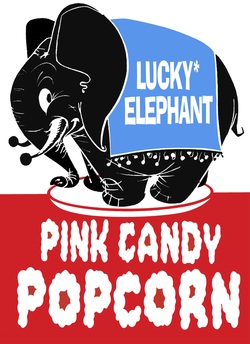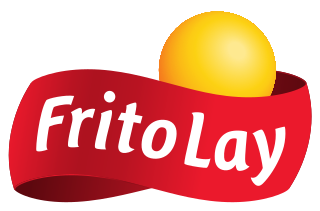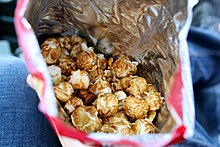
Popcorn is a variety of corn kernel which expands and puffs up when heated; the same names also refer to the foodstuff produced by the expansion.

Cheetos is a crunchy corn puff snack brand made by Frito-Lay, a subsidiary of PepsiCo. Fritos creator Charles Elmer Doolin invented Cheetos in 1948, and began national distribution in the United States. The initial success of Cheetos was a contributing factor to the merger between The Frito Company and H.W. Lay & Company in 1961 to form Frito-Lay. In 1965 Frito-Lay became a subsidiary of The Pepsi-Cola Company, forming PepsiCo, the current owner of the Cheetos brand.

Caramel corn or caramel popcorn is a confection made of popcorn coated with a sugar or molasses based caramel candy shell that is normally less than 1mm thick. Typically a sugar solution or syrup is made and heated until it browns and becomes thick, producing a caramelized candy syrup. This hot candy is then mixed with popped popcorn, and allowed to cool. Sometimes, a candy thermometer is used, as making caramel is time-consuming and requires skill to make well without burning the sugar. The process creates a sweet flavored, crunchy snack food or treat. Some varieties, after coating with the candy syrup, are baked in an oven to crisp the mixture. Mixes of caramel corn sometimes contain nuts, such as peanuts, pecans, almonds, or cashews.

Puffed rice and popped rice are types of puffed grain made from rice commonly eaten in the traditional cuisines of India, Southeast Asia, East Asia, and South Asia. It has also been produced commercially in the West since 1904 and is popular in breakfast cereals and other snack foods.

Fiddle Faddle is candy-coated popcorn produced by ConAgra Foods. Introduced in 1967, the snack is commonly found in US discount and drug stores. Fiddle Faddle consists of popped popcorn covered with either caramel or butter toffee and mixed with peanuts.
Cracker Jack is a snack consisting of caramel-coated popcorn and peanuts.

Lolly Gobble Bliss Bombs are an Australian snack food made by the Greens food company.
Loyalty marketing is a marketing strategy in which a company focuses on growing and retaining existing customers through incentives. Branding, product marketing, and loyalty marketing all form part of the customer proposition – the subjective assessment by the customer of whether to purchase a brand or not based on the integrated combination of the value they receive from each of these marketing disciplines.

Jays Foods, Inc., is an American manufacturer of snack products including potato chips, popcorn and pretzels. Jays Foods was founded in 1927 in Chicago, Illinois, and is currently a subsidiary of Snyder's of Hanover. Operating in several Midwestern states, Jays Foods' potato chips and popcorn maintain significant shares of their respective markets.

Crunch 'n Munch is an American brand of snack food produced by Conagra Brands consisting of caramel-coated popcorn and peanuts. It comes in its original form of Buttery Toffee, as well as Maple, Caramel, Chocolate & Caramel, Molasses, Almond Supreme, French Vanilla, Kettle Corn, Light, Fat Free, Sweet & Salty, Sweet & Hot and Premium Nut.

Lucky Elephant Pink Candy Popcorn is a Canadian confection that has been on the snack food market since the 1950s. It is commonly found retailed at mom and pop grocery stores, carnivals, concession stands, arenas and neighbourhood food outlets, and more recently is being launched in major grocery outlets across Canada.

The Lincoln Snacks Company was a manufacturer of caramelized popcorn and popcorn/nut mixes. Lincoln Snacks’ products are produced in Lincoln, Nebraska and sold nationally under the Poppycock, Fiddle Faddle and Screaming Yellow Zonkers (discontinued) brand names. Lincoln Snacks became a subsidiary of ConAgra Foods, Inc. on September 7, 2007.
The Weaver Popcorn Company, based in Van Buren, Indiana, is one of the largest popcorn companies in the United States.

Frito-Lay, Inc. is an American subsidiary of PepsiCo that manufactures, markets, and sells corn chips, potato chips, and other snack foods. The primary snack food brands produced under the Frito-Lay name include Fritos corn chips, Cheetos cheese-flavored snacks, Doritos and Tostitos tortilla chips, Lay's and Ruffles potato chips, Rold Gold pretzels, and Walkers potato crisps. Each brand generated annual worldwide sales over $1 billion in 2009.
Prizes are promotional items—small toys, games, trading cards, collectables, and other small items of nominal value—found in packages of brand-name retail products that are included in the price of the product with the intent to boost sales, similar to toys in kid's meals. Collectable prizes produced in series are used extensively—as a loyalty marketing program—in food, drink, and other retail products to increase sales through repeat purchases from collectors. Prizes have been distributed through bread, candy, cereal, cheese, chips, crackers, laundry detergent, margarine, popcorn, and soft drinks. The types of prizes have included comics, fortunes, jokes, key rings, magic tricks, models, pin-back buttons, plastic mini-spoons, puzzles, riddles, stickers, temporary tattoos, tazos, trade cards, trading cards, and small toys. Prizes are sometimes referred to as "in-pack" premiums, although historically the word "premium" has been used to denote an item that is not packaged with the product and requires a proof of purchase and/or a small additional payment to cover shipping and/or handling charges.

Dagashi refers to cheap candies and snack foods. Dagashi are comparable to American penny candy.
Wyandot Snacks is a privately held and family owned American contract manufacturer of snacks and other packaged foods, headquartered in Marion, Ohio, a part of the Columbus, Ohio Combined statistical area. primarily as a contract manufacturer for domestic and international branded snack businesses, but also for foodservice customers. The company's main product lines are extruded snacks, corn & tortilla chips, and ready to eat (RTE) popcorn. Wyandot's focuses on the creation of plant-based snack products made from ancient grains such as sorghum and quinoa, pulses such as chickpeas, and flaxseed, among others.
Frito-Lay Canada, Inc., formerly the Hostess Frito-Lay Company, is a Canadian division of the U.S.-based Frito-Lay owned as a subsidiary of PepsiCo that manufactures, markets and sells corn chips, potato chips and other snack foods. The primary snack food brands produced under the Frito-Lay name include Fritos corn chips, Cheetos cheese-flavored snacks, Doritos and Tostitos tortilla chips, Lay's and Ruffles potato chips, Smartfood flavored popcorn and Rold Gold pretzels. The company is headquartered in Mississauga, Ontario and has four production plants in Cambridge, Ontario; Lévis, Quebec; Kentville, Nova Scotia; and Taber/Lethbridge, Alberta.

















